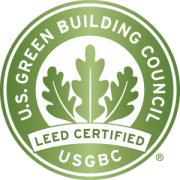Sustainability
At Atrium, our environmentally friendly approach to landscape design dates back to our very beginnings. We have continually advanced our efforts in this area, and the sustainable practices we use today are grounded in research supporting land development guidelines that can restore or enhance the ecosystem and prove cost-effective. These practices are also supported by the development of new green materials and treatments that include green roofs and permeable pavements. In fact, we employ sustainable equipment and practices in the office as well as out in the field.
Approach
Putting sustainability into practice
We follow the sustainable practices guidelines developed by the Sustainable Sites Initiative (SSI). Modeled after the green building, or LEED, standards developed by the U.S. Green Building Council (USGBC), the guidelines of the SSI promote the sustainable use of water, the conservation of soils, environmentally efficient choices of vegetation and materials, and design that supports human health and well-being.
To learn more, visit the Sustainable Sites Initiative website at www.sustainablesites.org.
Sustainability in our work
Green roofs, permeable pavements and the restoration of a three-acre prairie savanna are among our sustainable projects, and we take great care and great pride in being environmentally responsible in all of our landscape work. These practices include:
- Recycling of plastic plant containers
- Recycling of all plastic, aluminum, paper, etc.
- Recycling of all landscape waste
- Using recycled landscape compost
- Recycling/mulching lawnmowers that use biofuel
- Employing low noise/emission blowers, trimmers
- Using/recommending native or noninvasive plants
- Installing permeable paver driveway and parking
- Restoring a three acre prairie savanna
Sustainability in our office
At Atrium, being environmentally conscious means integrating sustainable practices in our workplace. These practices include:
- Recycling of plastics, aluminum, paper, etc.
- Installing a high efficiency furnace and waterless hot water tank
- Creating a nearly paperless office environment.
- Using 100% recycled paper when paper is used
- Replacing all lighting with fluorescent bulbs

